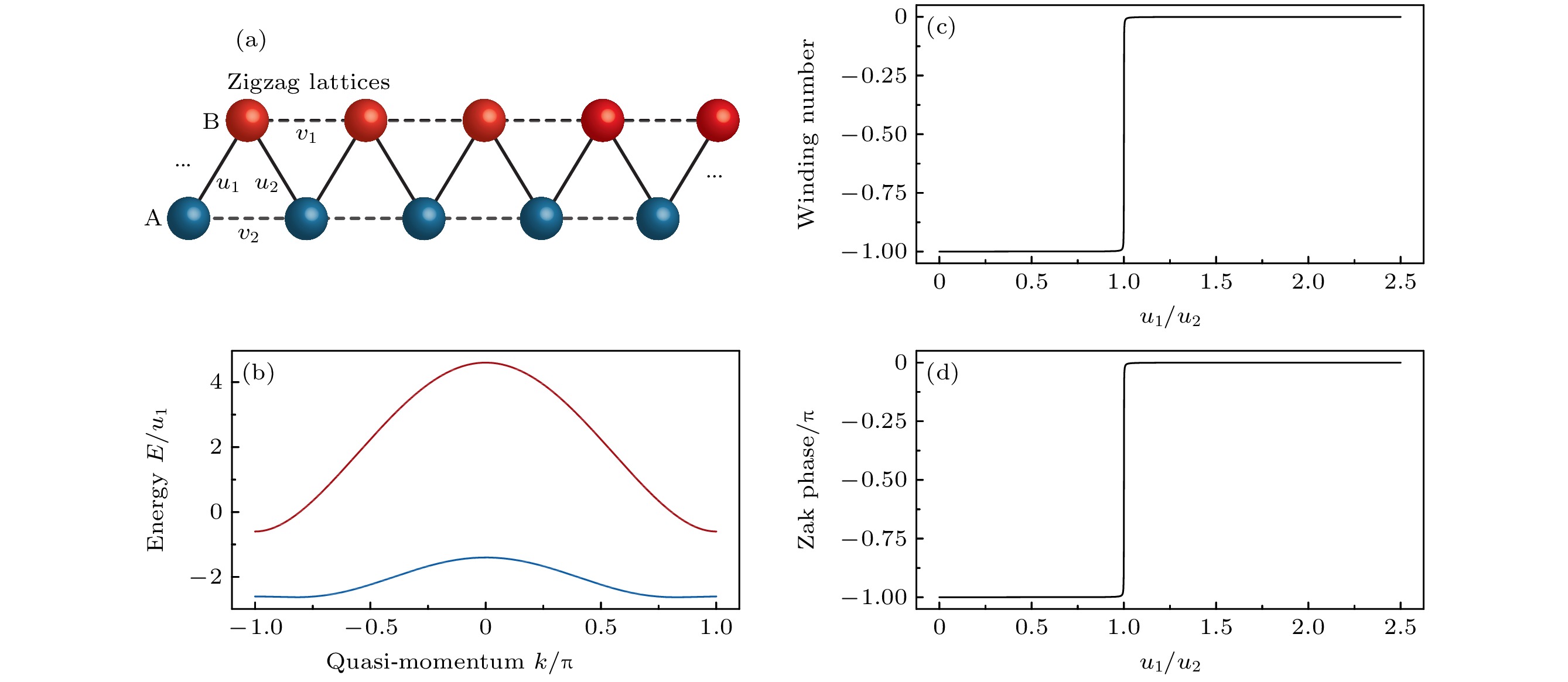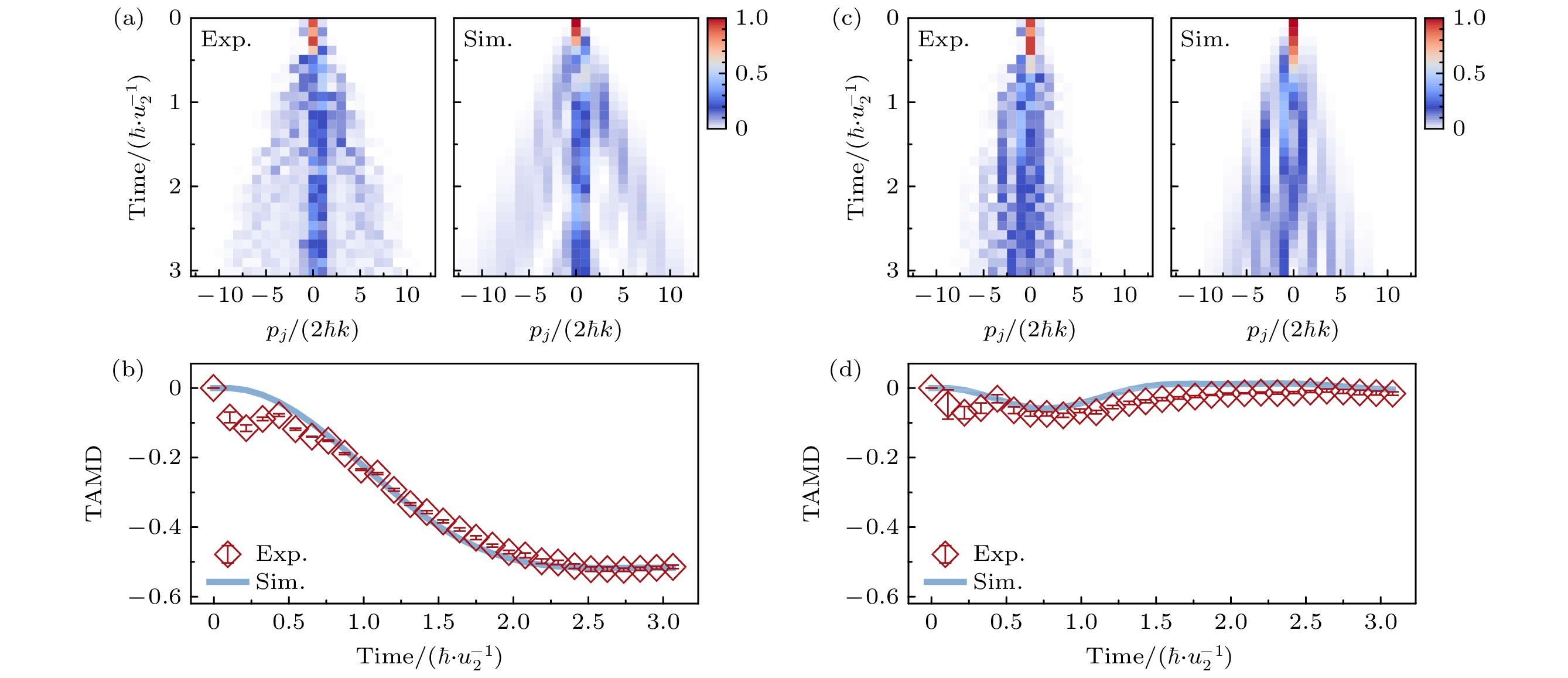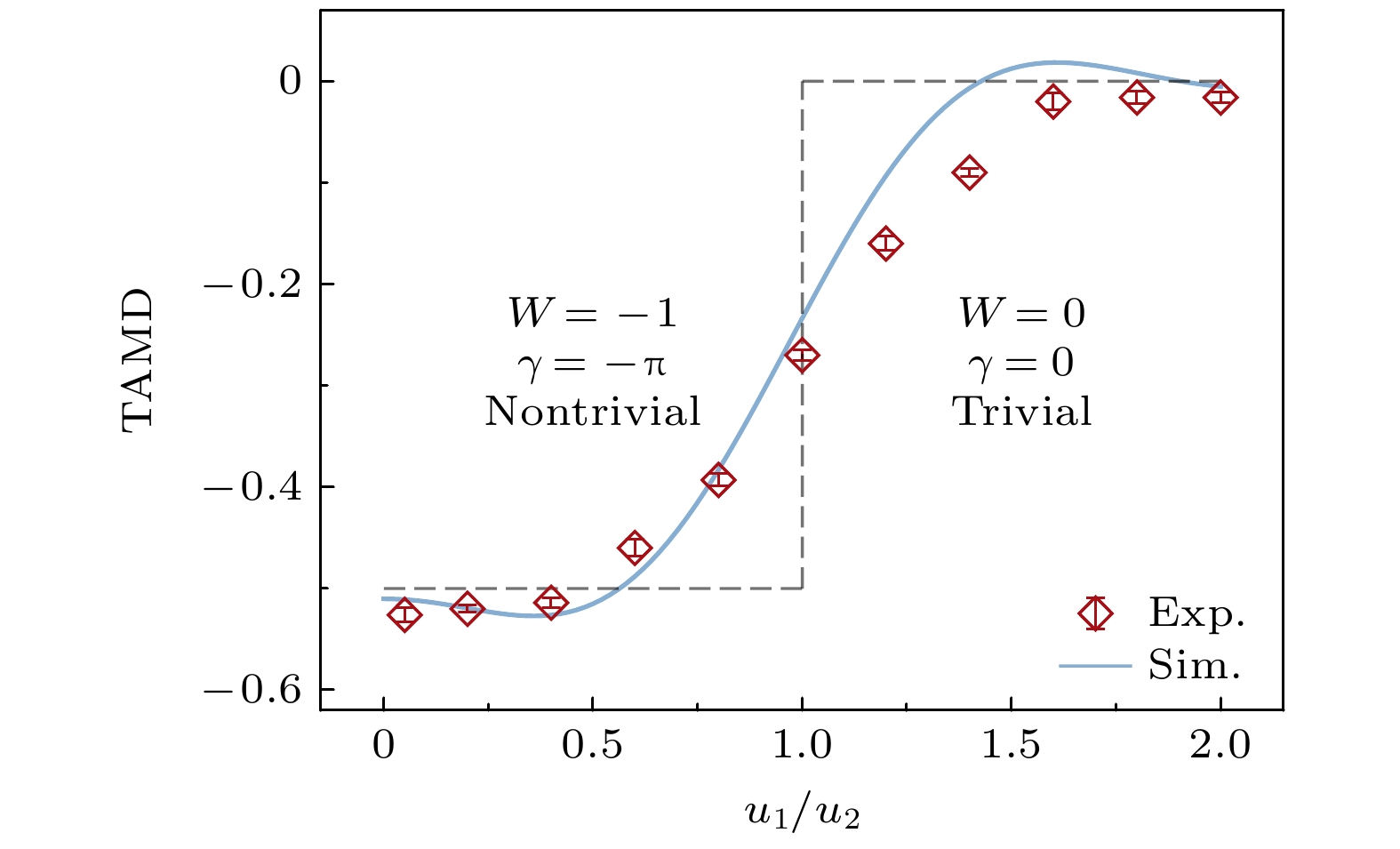-
对称性在理解物质的拓扑态方面具有关键作用. 过去人们认为手征对称性保证了一维晶格的量子化Zak相位及其对应的非平庸拓扑相. 本文展现了在一维手征对称性破缺的情况下, 晶格系统仍具有量子化Zak相位和非平庸拓扑相. 具体而言, 在超冷原子动量晶格系统中有效地模拟了一个链长为26、手征对称性破缺的Zigzag模型, 其中相等的次近邻耦合强度能够在保留空间反演对称性的同时破坏手征对称性. 通过测量原子的时间平均波包位移来获得系统的拓扑不变量, 并得到了其对应的量子化的Zak相位. 此外, 还观测到系统随着最近邻耦合强度比例的变化会从非平庸拓扑相转变为平庸拓扑相. 本文不仅为对称性及拓扑相的相关研究提供了一个完全可控的平台, 还可以通过控制格点间耦合强度和原子间相互作用, 探索例如Tasaki, Aharonov-Bohm caging模型中的平带拓扑以及引入相互作用研究的非线性拓扑现象.Symmetry plays a crucial role in understanding topological phases in materials. In one-dimensional systems, such as the Su-Schrieffer-Heeger (SSH) model, chiral symmetry is thought to ensure the quantization of the Zak phase and the nontrivial topological phase. However, our work demonstrates that the one-dimensional lattice system with broken chiral symmetry can still possess quantized Zak phase and nontrivial topological phase. Specifically, we use a Bose-Einstein condensate of 87Rb atoms in a momentum space lattice of ultracold atoms to effectively simulate a one-dimensional Zigzag model of 26 sites, which intrinsically breaks the chiral symmetry by additional next-nearest-neighbor coupling. To ensure the existence of the nontrivial topological phase, where the Zak phase can be measured from the time-averaged displacement during the system’s evolution, we need to preserve the inversion symmetry by modulating laser power so that all next-nearest-neighbor coupling strengths are equal. Furthermore, by changing the ratio of nearest-neighbor coupling strengths, we observe a topological phase transition from a nontrivial topological phase to a trivial topological phase at the point where the ratio equals 1. Our work demonstrates that the ultracold atom system provides a controllable platform for studying the symmetrical phase and topological phase, with the potential to explore nonlinear topological phenomena by increasing the interactions among atoms. In addition, our system can be used to investigate other interesting topological phenomena with more complex models, such as critical phenomena at the phase transitions and flat band structures in the extended SSH model with long-range coupling. By controlling the coupling strengths, we can also explore the influence of different symmetries on the topological properties of extended SSH models in the future. Moreover, our platform makes it possible to studythe models with more energy bands, such as the Aharonov-Bohm caging model with a three-level structure, which shows peculiar flat-band properties. This work provides opportunities for various studies in the fields of symmetry, topology, and the interaction of controllable quantum systems.
-
Keywords:
- symmetry /
- topological invariant /
- Zak phase /
- momentum space lattice
[1] Klitzing K V, Dorda G, Pepper M 1980 Phys. Rev. Lett. 45 494
 Google Scholar
Google Scholar
[2] Tsui D C, Stormer H L, Gossard A C 1982 Phys. Rev. Lett. 48 1559
 Google Scholar
Google Scholar
[3] Hasan M Z, Kane C L 2010 Rev. Mod. Phys. 82 3045
 Google Scholar
Google Scholar
[4] Nayak C, Simon S H, Stern A, Freedman M, Sarma S D 2008 Rev. Mod. Phys. 80 1093
 Google Scholar
Google Scholar
[5] Qi X L, Zhang S C 2011 Rev. Mod. Phys. 83 1057
 Google Scholar
Google Scholar
[6] Huang S M, Xu S Y, Belopolski I, et al. 2015 Nat. Commun. 6 7373
 Google Scholar
Google Scholar
[7] Chiu C K, Teo J C Y, Schnyder A P, Ryu S 2016 Rev. Mod. Phys. 88 035005
 Google Scholar
Google Scholar
[8] Ryu S, Schnyder A P, Furusaki A, Ludwig A W W 2010 New J. Phys. 12 065010
 Google Scholar
Google Scholar
[9] Su W P, Schrieffer J R, Heeger A J 1979 Phys. Rev. Lett. 42 1698
 Google Scholar
Google Scholar
[10] Zak J 1989 Phys. Rev. Lett. 62 2747
 Google Scholar
Google Scholar
[11] Atala M, Aidelsburger M, Barreiro J T, Abanin D, Kitagawa T, Demler E, Bloch I 2013 Nat. Phys. 9 795
 Google Scholar
Google Scholar
[12] Cardano F, D’Errico A, Dauphin A, et al. 2017 Nat. Commun. 8 15516
 Google Scholar
Google Scholar
[13] Li G Z, Wang L J, Ye R, Zheng Y L, Wang D W, Liu X J, Dutt A, Yuan L Q, Chen X F 2023 Light Sci. Appl. 12 81
 Google Scholar
Google Scholar
[14] Meier E J, An F A, Dauphin A, Maffei M, Massignan P, Hughes T L, Gadway B 2018 Science 362 929
 Google Scholar
Google Scholar
[15] Xie D Z, Deng T S, Xiao T, Gou W, Chen T, Yi W, Yan B 2020 Phys. Rev. Lett. 124 050502
 Google Scholar
Google Scholar
[16] Choi J Y, Hild S, Zeiher J, Schauß P, Rubio-Abadal A, Yefsah T, Khemani V, Huse D A, Bloch I, Gross C 2016 Science 352 1547
 Google Scholar
Google Scholar
[17] 苑涛 戴汉宁 陈宇翱 2023 物理学报 72 160302
 Google Scholar
Google Scholar
Yuan T, Dai H N, Chen Y A 2023 Acta Phys. Sin. 72 160302
 Google Scholar
Google Scholar
[18] Miert G V, Ortix C, Smith C M 2017 2D Mater. 4 015023
[19] Pérez-González B, Bello M, Gómez-León Á, Platero G 2019 Phys. Rev. B 99 035146
 Google Scholar
Google Scholar
[20] Ahmadi N, Abouie J 2020 Phys. Rev. B 101 195117
 Google Scholar
Google Scholar
[21] Altland A, Zirnbauer M R 1997 Phys. Rev. B 55 1142
 Google Scholar
Google Scholar
[22] Schnyder A P, Ryu S, Furusaki A, Ludwig A W W 2008 Phys. Rev. B 78 195125
 Google Scholar
Google Scholar
[23] Morimoto T, Furusaki A 2013 Phys. Rev. B 88 125129
 Google Scholar
Google Scholar
[24] Jiao Z Q, Longhi S, Wang X W, Gao J, Zhou W H, Wang Y, Fu Y X, Wang L, Ran R J, Qiao L F, Jin X M 2021 Phys. Rev. Lett. 127 147401
 Google Scholar
Google Scholar
[25] Jotzu G, Messer M, Desbuquois R, Lebrat M, Uehlinger T, Greif D, Esslinger T 2014 Nature 515 237
 Google Scholar
Google Scholar
[26] Aidelsburger M, Lohse M, Schweizer C, Atala M, Barreiro J T, Nascimbéne S, Cooper N R, Bloch I, Goldman N 2015 Nat. Phys. 11 612
 Google Scholar
Google Scholar
[27] Longhi S 2018 Opt. Lett. 43 4639
 Google Scholar
Google Scholar
[28] Gadway B 2015 Phys. Rev. A 92 043606
 Google Scholar
Google Scholar
[29] An F A, Meier E J, Gadway B 2018 Phys. Rev. X 8 031045
 Google Scholar
Google Scholar
[30] Rufo S, Lopes N, Continentino M A, Griffith M A R 2019 Phys. Rev. B 100 195432
 Google Scholar
Google Scholar
[31] Pyykkönen V A J, Peotta S, Fabritius P, Mohan J, Esslinger T, Törmä P 2021 Phys. Rev. B 103 144519
 Google Scholar
Google Scholar
[32] Kremer M, Petrides I, Meyer E, Heinrich M, Zilberberg O, Szameit A 2020 Nat. Commun. 11 907
 Google Scholar
Google Scholar
[33] Cáceres-Aravena G, Guzmán-Silva D, Salinas I, Vicencio R A 2022 Phys. Rev. Lett. 128 256602
 Google Scholar
Google Scholar
[34] Li H, Dong Z L, Longhi S, Liang Q, Xie D Z, Yan B 2022 Phys. Rev. Lett. 129 220403
 Google Scholar
Google Scholar
[35] Zhang W X, Wang H T, Sun H J, Zhang X D 2023 Phys. Rev. Lett. 130 206401
 Google Scholar
Google Scholar
-
图 1 (a) 一维Zigzag模型示意图, 格点之间的最近邻耦合强度为$ u_1 $和$ u_2 $, 次近邻耦合强度为$ v_1 $和$ v_2 $; (b) Zigzag模型的能带分布图; (c), (d)在系统不同的$ u_1/u_2 $情况下, Zigzag模型的环绕数和Zak相位的变化结果, 参数为$ v_1=v_2 $, $ v_1/u_2=0.4 $
Fig. 1. (a) Schematic diagram of a one-dimensional (1D) Zigzag model with nearest-neighbor coupling strengths $ u_1 $ and $ u_2 $ and next-nearest-neighbor coupling strengths $ v_1 $ and $ v_2 $; (b) band structure of the Zigzag model; (c), (d) variations of the winding number and Zak phase of the Zigzag model as a function of $ u_1/u_2 $, with parameters $ v_1 = v_2 $ and $ v_1/u_2 = 0.4 $.
图 2 实现一维Zigzag晶格 (a)利用Bragg过程实现一维动量晶格(上部分)和通过时间飞行成像探测原子数分布(下部分); (b)动量晶格中的原子色散曲线, 分别利用一阶和二阶Bragg跃迁耦合最近邻和次近邻格点
Fig. 2. Realization of 1D Zigzag lattice: (a) 1D momentum lattice realized using Bragg processes (upper part) and visualized via time-of-flight imaging (lower part); (b) atomic dispersion curve in the momentum lattice includes first-order and second-order Bragg transitions, which are used to couple the nearest-neighbor and next-nearest-neighbor lattice sites.
图 3 时间平均波包位移的测量 (a) $ u_1/u_2=2 $时, 系统的动力学演化过程, 其中左图为实验结果, 右图为数值模拟结果; (b) 通过(5)式得到的图(a)对应的TAMD的演化结果; (c), (d) $ u_1/u_2=0.4 $时, 测量得到的动力学演化过程和TAMD演化结果. 图中采用的实验参数: L = 26, $ v_1=v_2=0.15 $ kHz, $ u_2=0.35 $ kHz, 演化时长为$ 3.1\hbar/u_2 $, 时间间隔为$ 0.11\hbar/u_2 $
Fig. 3. Measurement of time-averaged wavepacket displacement: (a) Dynamics evolution of the system for $ u_1/u_2=2 $, where the left plot shows experimental results, and the right plot presents numerical simulations; (b) evolution of TAMD corresponding to panel (a) obtained using Eq. (5); (c), (d) dynamics evolution and TAMD results were obtained for $ u_1/u_2=0.4 $. Experimental parameters: L = 26, $ v_1=v_2=0.15 $ kHz, $ u_2=0.35 $ kHz, an evolution time of $ 3.1\hbar/u_2 $, and a time interval of $ 0.11\hbar/u_2 $.
-
[1] Klitzing K V, Dorda G, Pepper M 1980 Phys. Rev. Lett. 45 494
 Google Scholar
Google Scholar
[2] Tsui D C, Stormer H L, Gossard A C 1982 Phys. Rev. Lett. 48 1559
 Google Scholar
Google Scholar
[3] Hasan M Z, Kane C L 2010 Rev. Mod. Phys. 82 3045
 Google Scholar
Google Scholar
[4] Nayak C, Simon S H, Stern A, Freedman M, Sarma S D 2008 Rev. Mod. Phys. 80 1093
 Google Scholar
Google Scholar
[5] Qi X L, Zhang S C 2011 Rev. Mod. Phys. 83 1057
 Google Scholar
Google Scholar
[6] Huang S M, Xu S Y, Belopolski I, et al. 2015 Nat. Commun. 6 7373
 Google Scholar
Google Scholar
[7] Chiu C K, Teo J C Y, Schnyder A P, Ryu S 2016 Rev. Mod. Phys. 88 035005
 Google Scholar
Google Scholar
[8] Ryu S, Schnyder A P, Furusaki A, Ludwig A W W 2010 New J. Phys. 12 065010
 Google Scholar
Google Scholar
[9] Su W P, Schrieffer J R, Heeger A J 1979 Phys. Rev. Lett. 42 1698
 Google Scholar
Google Scholar
[10] Zak J 1989 Phys. Rev. Lett. 62 2747
 Google Scholar
Google Scholar
[11] Atala M, Aidelsburger M, Barreiro J T, Abanin D, Kitagawa T, Demler E, Bloch I 2013 Nat. Phys. 9 795
 Google Scholar
Google Scholar
[12] Cardano F, D’Errico A, Dauphin A, et al. 2017 Nat. Commun. 8 15516
 Google Scholar
Google Scholar
[13] Li G Z, Wang L J, Ye R, Zheng Y L, Wang D W, Liu X J, Dutt A, Yuan L Q, Chen X F 2023 Light Sci. Appl. 12 81
 Google Scholar
Google Scholar
[14] Meier E J, An F A, Dauphin A, Maffei M, Massignan P, Hughes T L, Gadway B 2018 Science 362 929
 Google Scholar
Google Scholar
[15] Xie D Z, Deng T S, Xiao T, Gou W, Chen T, Yi W, Yan B 2020 Phys. Rev. Lett. 124 050502
 Google Scholar
Google Scholar
[16] Choi J Y, Hild S, Zeiher J, Schauß P, Rubio-Abadal A, Yefsah T, Khemani V, Huse D A, Bloch I, Gross C 2016 Science 352 1547
 Google Scholar
Google Scholar
[17] 苑涛 戴汉宁 陈宇翱 2023 物理学报 72 160302
 Google Scholar
Google Scholar
Yuan T, Dai H N, Chen Y A 2023 Acta Phys. Sin. 72 160302
 Google Scholar
Google Scholar
[18] Miert G V, Ortix C, Smith C M 2017 2D Mater. 4 015023
[19] Pérez-González B, Bello M, Gómez-León Á, Platero G 2019 Phys. Rev. B 99 035146
 Google Scholar
Google Scholar
[20] Ahmadi N, Abouie J 2020 Phys. Rev. B 101 195117
 Google Scholar
Google Scholar
[21] Altland A, Zirnbauer M R 1997 Phys. Rev. B 55 1142
 Google Scholar
Google Scholar
[22] Schnyder A P, Ryu S, Furusaki A, Ludwig A W W 2008 Phys. Rev. B 78 195125
 Google Scholar
Google Scholar
[23] Morimoto T, Furusaki A 2013 Phys. Rev. B 88 125129
 Google Scholar
Google Scholar
[24] Jiao Z Q, Longhi S, Wang X W, Gao J, Zhou W H, Wang Y, Fu Y X, Wang L, Ran R J, Qiao L F, Jin X M 2021 Phys. Rev. Lett. 127 147401
 Google Scholar
Google Scholar
[25] Jotzu G, Messer M, Desbuquois R, Lebrat M, Uehlinger T, Greif D, Esslinger T 2014 Nature 515 237
 Google Scholar
Google Scholar
[26] Aidelsburger M, Lohse M, Schweizer C, Atala M, Barreiro J T, Nascimbéne S, Cooper N R, Bloch I, Goldman N 2015 Nat. Phys. 11 612
 Google Scholar
Google Scholar
[27] Longhi S 2018 Opt. Lett. 43 4639
 Google Scholar
Google Scholar
[28] Gadway B 2015 Phys. Rev. A 92 043606
 Google Scholar
Google Scholar
[29] An F A, Meier E J, Gadway B 2018 Phys. Rev. X 8 031045
 Google Scholar
Google Scholar
[30] Rufo S, Lopes N, Continentino M A, Griffith M A R 2019 Phys. Rev. B 100 195432
 Google Scholar
Google Scholar
[31] Pyykkönen V A J, Peotta S, Fabritius P, Mohan J, Esslinger T, Törmä P 2021 Phys. Rev. B 103 144519
 Google Scholar
Google Scholar
[32] Kremer M, Petrides I, Meyer E, Heinrich M, Zilberberg O, Szameit A 2020 Nat. Commun. 11 907
 Google Scholar
Google Scholar
[33] Cáceres-Aravena G, Guzmán-Silva D, Salinas I, Vicencio R A 2022 Phys. Rev. Lett. 128 256602
 Google Scholar
Google Scholar
[34] Li H, Dong Z L, Longhi S, Liang Q, Xie D Z, Yan B 2022 Phys. Rev. Lett. 129 220403
 Google Scholar
Google Scholar
[35] Zhang W X, Wang H T, Sun H J, Zhang X D 2023 Phys. Rev. Lett. 130 206401
 Google Scholar
Google Scholar
计量
- 文章访问数: 6286
- PDF下载量: 281
- 被引次数: 0














 下载:
下载:



